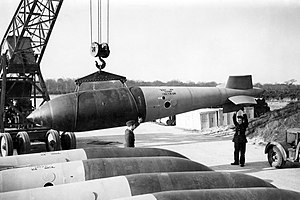Grand Slam (bomb)
| Grand Slam | |
|---|---|

A Grand Slam bomb being handled at RAF Woodhall Spa
|
|
| Type | Earthquake bomb |
| Place of origin | United Kingdom |
| Service history | |
| In service | 1945 |
| Used by | Royal Air Force |
| Wars | World War II |
| Production history | |
| Designer | Barnes Wallis |
| Designed | 1943 |
| Manufacturer |
Vickers, Sheffield Clyde Alloy/Steel Company of Scotland, Blochairn, Glasgow |
| Produced | 1944–45 |
| No. built | 42 used, 99 built by Clyde Alloy plus others from the Smith Corporation of America |
| Variants | M110 (T-14) 22,000-lb GP Bomb (United States) |
| Specifications | |
| Weight | 22,000 lb (10,000 kg) |
| Length | 26 ft 6 in (8.08 m) |
| length | Tail 13 ft 6 in (4.11 m) |
| Diameter | 3 ft 10 in (1.17 m) |
|
|
|
| Filling | Torpex D1 |
| Filling weight | 4,144 kg (9,136 lb) |
|
Detonation
mechanism |
penetration: 40 m (130 ft) (earth) 2–6 m (20 ft) (concrete) |
| Blast yield | 6.5 tons TNT equivalent |
The Grand Slam was a 22,000 lb (10,000 kg) earthquake bomb used by RAF Bomber Command against strategic targets during the Second World War. It was the most powerful non-atomic bomb used in the war.
Known officially as the Bomb, Medium Capacity, 22,000 lb, it was a scaled-up version of the Tallboy bomb and closer to the original size that the bombs' inventor, Barnes Wallis, had envisaged when he first developed his earthquake bomb idea. It was also nicknamed "Ten ton Tess".
When the success [of the Tallboy bomb] was proved, Wallis designed a yet more powerful weapon… This 22,000 lb. bomb did not reach us before the spring of 1945, when we used it with great effect against viaducts or railways leading to the Ruhr and also against several U-boat shelters. If it had been necessary, it would have been used against underground factories, and preparations for attacking some of these were well advanced when the war ended.
On 18 July 1943, work started on a larger version of the Tallboy bomb, which became the Grand Slam. As with the original Tallboy, the Grand Slam's fins generated a stabilizing spin and the bomb had a thicker case than a conventional bomb, which allowed deeper penetration. After the hot molten Torpex was poured into the casing, the explosive took a month to cool and set. Like the Tallboy, because of the low rate of production and consequent high value of each bomb, aircrews were told to land with their unused bombs on board rather than jettison them into the sea if a sortie was aborted.
After release from the Avro Lancaster B.Mk 1 (Special) bomber, the Grand Slam would reach near-supersonic speed, approaching 1,049 ft/s (320 m/s), 715 mph (1150 km/h). When it hit, it would penetrate deep underground before detonating. The resulting explosion could cause the formation of a camouflet (cavern) and shift the ground to undermine a target's foundation.
Unlike Tallboy, Grand Slam was originally designed to penetrate concrete roofs. Consequently, it was more effective against hardened targets than any existing bomb.
...
Wikipedia
